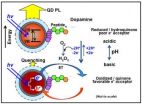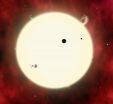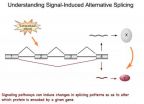(Press-News.org) Scientists at the Naval Research Laboratory (NRL) in conjunction with the Scripps Research Institute in La Jolla, Ca., recently reported a detailed study of the interactions of water soluble semi-conductor quantum dots (QDs) with the electro-active neuro-transmitter dopamine. These biocompatible QD-dopamine nano-assemblies may be used as the active component for sensors that are used to detect a wide variety of target analytes ranging from sugars to peroxides.
According to NRL's Dr. Michael Stewart, a member of the research team "The nature of the QD-dopamine interaction has been the subject of more than 25 recent research papers that attempted to uncover and exploit the exact nature of how the QDs interact with these small electro-active chemicals during the sensing process. Until now, it remained unclear as to whether dopamine acted as an electron acceptor or as an electron donor to quench luminescence from the QD."
"The chemical state of dopamine changes from a protonated hydroquinone in acidic media to an oxidized quinone in basic environments. A series of carefully designed experiments allowed the research team to establish that only the quinone form is capable of acting as an electron acceptor resulting in quenching of the QD emission. The rate of quinone formation and hence QD quenching is directly proportional to pH and can therefore be used to detect changes in the pH of solutions. Using this nano-scale sensor, the research team was able to demonstrate pH sensing in solution and even visualize changes inside cells as cell cultures underwent drug-induced alkalosis," explained Dr. Scott Trammell.
INFORMATION:
The interdisciplinary group of scientists involved in this project from NRL include: Dr. Michael Stewart and Dr. Kimihiro Susumu of NRL's Optical Sciences Division, and Dr. Igor Medintz, Dr. Scott Trammell, and Dr. James Delehanty from NRL's Center for Bio/Molecular Science and Engineering, along with Professor Phillip Dawson and Dr. Juan B. Blanco-Canosa of the Scripps Research Institute.
This research was supported by NRL's Nanoscience Institute and the Defense Threat Reduction Agency (DTRA), and is focused on areas tasked to the Department of Defense under the President's National Nanotechnology Initiative. The research was published in the August 2010 issue of Nature Materials.
NRL scientists unravel complex quantum dot-dopamine interactions
2010-10-17
ELSE PRESS RELEASES FROM THIS DATE:
Squid studies provide valuable insights into hearing mechanisms
2010-10-17
The ordinary squid, Loligo pealii—best known until now as a kind of floating buffet for just about any fish in the sea—may be on the verge of becoming a scientific superstar, providing clues about the origin and evolution of the sense of hearing.
In a hangar-like research building at the Woods Hole Oceanographic Institution (WHOI), biologist T. Aran Mooney is exploring virtually uncharted waters: Can squid hear? Is their hearing sensitive enough to hear approaching predators? How do squid and other marine species rely on sound to interact, migrate, and communicate? Will ...
Study confirms: Whatever doesn't kill us can make us stronger
2010-10-17
BUFFALO, N.Y. -- We've all heard the adage that whatever doesn't kill us makes us stronger, but until now the preponderance of scientific evidence has offered little support for it.
However, a new national multi-year longitudinal study of the effects of adverse life events on mental health has found that adverse experiences do, in fact, appear to foster subsequent adaptability and resilience, with resulting advantages for mental health and well being.
The study, "Whatever Does Not Kill Us: Cumulative Lifetime Adversity, Vulnerability and Resilience," to be published in ...
Right foods aid memory and protect against disease
2010-10-17
For the first time researchers have found out what effect multiple, rather than just single, foods with anti-inflammatory effects have on healthy individuals.
The results of a diet study show that bad cholesterol was reduced by 33 per cent, blood lipids by 14 per cent, blood pressure by 8 per cent and a risk marker for blood clots by 26 per cent. A marker of inflammation in the body was also greatly reduced, while memory and cognitive function were improved.
"The results have exceeded our expectations! I would like to claim that there has been no previous study ...
Missouri Botanical Garden researcher discover new genus
2010-10-17
An article published in the October issue of the Annals of the Missouri Botanical Garden describes a new genus of tree of the Aptandraceae family, a group that is related to the sandalwoods (order Santalales). The genus, which has been given the name Hondurodendron, is endemic to Honduras and means "tree of Honduras."
In the article, "Hondurodendron, a New Monotypic Genus of Aptandraceae from Honduras," lead author Dr. Carmen Ulloa, associate curator at the Missouri Botanical Garden, and co-authors
Dr. Daniel L. Nickrent, Southern Illinois University-Carbondale, Dr. ...
How to weigh a star using a moon
2010-10-17
How do astronomers weigh a star that's trillions of miles away and way too big to fit on a bathroom scale? In most cases they can't, although they can get a best estimate using computer models of stellar structure.
New work by astrophysicist David Kipping says that in special cases, we can weigh a star directly. If the star has a planet, and that planet has a moon, and both of them cross in front of their star, then we can measure their sizes and orbits to learn about the star.
"I often get asked how astronomers weigh stars. We've just added a new technique to our toolbox ...
Images shed new light on inflammation
2010-10-17
Calgary, AB - Researchers at the University of Calgary Faculty of Medicine are using an innovative new imaging technique to study how white blood cells (called neutrophils) respond to inflammation, and have revealed new targets to inhibit the response.
When the body is invaded by infection, the immune system counters by generating inflammation with deployment of white blood cells to the site of danger to kill invading bacteria. However, inappropriate inflammation occurs in the absence of infection when tissues are damaged, and this inappropriate response contributes ...
Beauty is in the eye of the beholder the world over
2010-10-17
Western culture is increasingly obsessed with physical appearance and beauty, but vanity is nothing new, nor is it limited to just one culture. Moreover, differences in our perception of physical beauty have an enormous impact on the fashion, cosmetics, and weight control industries, and more recently on aesthetic surgery trends. Understanding how culture and region alter the perception of beauty is therefore not only of anthropological and social interest but underpins multibillion dollar industries across the globe.
According to Anil Mathur of Hofstra University in ...
Gynecologist disputes findings
2010-10-17
(Phoenix, Arizona October 15, 2010) -- An internationally-recognized gynecologic oncologist at St. Joseph's Hospital and Medical Center in Phoenix, Arizona is warning that the results from a long-awaited global study of ovarian cancer should be viewed cautiously.
Published in The Lancet last month, the study reported that women who received early chemotherapy for a recurrence of ovarian cancer did not live longer than those whose treatment is delayed. London-based, The Lancet is one of the world's most respected medical journals.
"While this study is a bold challenge ...
UCSF's Prusiner receives President's National Medal of Science
2010-10-17
UCSF Nobel laureate Stanley B. Prusiner, MD, UCSF professor of neurology and director of the Institute for Neurodegenerative Diseases, today (Oct. 15, 2010) was named to receive the National Medal of Science, the nation's highest honor for science and technology.
Prusiner was among 10 recipients named by President Barack Obama. In addition, three individuals and one team were named as recipients of the National Medal of Technology and Innovation. All of the awardees will receive their medals at a White House ceremony later this year.
The National Medal of Science honors ...
Shifting forms: Penn study shows how variations of same protein affect immune response
2010-10-17
PHILADELPHIA – How a T cell decides to make protein X, Y, or Z can have profound effects for fighting foreign invaders or staving off dire autoimmune reactions. Researchers at the University of Pennsylvania School of Medicine have identified the steps that control how different forms of an immune cell protein called CD45, which is critical for activating the immune system when faced with pathogens, are controlled in the arc of a body's immune response.
The shift between different forms of CD45 helps T cells function properly and also prevents hyperactivity, which could ...



